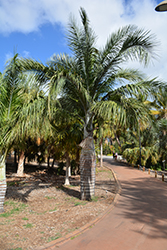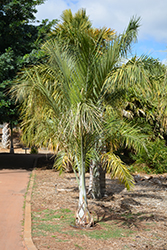It's all about ...
plants

Height: 35 feet
Spread: 20 feet
Sunlight:
![]()
![]()
Hardiness Zone: 10a
Other Names: Cherry Palm, Belly Palm, Cacheo Palm, Katie Palm
Description:
This handsome palm is widely used as an ornamental plant in warm temperate regions; adaptable and drought tolerant once established; trim away dead foliage to enhance appearance; very adaptable; an excellent landscape focal point
Ornamental Features
Wine Palm is primarily grown for its highly ornamental fruit. The fruits are showy scarlet drupes carried in abundance from late summer to early winter. It has attractive dark green foliage with grayish green undersides. The large glossy narrow pinnately compound leaves are highly ornamental and remain dark green throughout the winter. It has masses of beautiful panicles of creamy white flowers with chartreuse overtones hanging below the branches from early to late spring, which are most effective when planted in groupings. The smooth gray bark adds an interesting dimension to the landscape.
Landscape Attributes
Wine Palm is an evergreen tree with a strong central leader and a towering form, with a high canopy of foliage concentrated at the top of the plant. Its relatively fine texture sets it apart from other landscape plants with less refined foliage.
This tree will require occasional maintenance and upkeep, and should not require much pruning, except when necessary, such as to remove dieback. Gardeners should be aware of the following characteristic(s) that may warrant special consideration;
- Self-Seeding
Wine Palm is recommended for the following landscape applications;
- Accent
- Shade
- Vertical Accent
- Windbreaks and Shelterbelts
Planting & Growing
Wine Palm will grow to be about 35 feet tall at maturity, with a spread of 20 feet. It has a high canopy of foliage that sits well above the ground, and should not be planted underneath power lines. As it matures, the lower branches of this tree can be strategically removed to create a high enough canopy to support unobstructed human traffic underneath. It grows at a slow rate, and under ideal conditions can be expected to live for 60 years or more.
This tree does best in full sun to partial shade. It is very adaptable to both dry and moist growing conditions, but will not tolerate any standing water. It is considered to be drought-tolerant, and thus makes an ideal choice for xeriscaping or the moisture-conserving landscape. This plant does not require much in the way of fertilizing once established. It is particular about its soil conditions, with a strong preference for sandy, alkaline soils, and is able to handle environmental salt. It is highly tolerant of urban pollution and will even thrive in inner city environments. This species is not originally from North America..
This plant is not reliably hardy in our region, and certain restrictions may apply; contact the store for more information.

